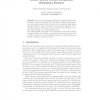Free Online Productivity Tools
i2Speak
i2Symbol
i2OCR
iTex2Img
iWeb2Print
iWeb2Shot
i2Type
iPdf2Split
iPdf2Merge
i2Bopomofo
i2Arabic
i2Style
i2Image
i2PDF
iLatex2Rtf
Sci2ools
ECCV
2010
Springer
2010
Springer
BRIEF: Binary Robust Independent Elementary Features
We propose to use binary strings as an efficient feature point descriptor, which we call BRIEF. We show that it is highly discriminative even when using relatively few bits and can be computed using simple intensity difference tests. Furthermore, the descriptor similarity can be evaluated using the Hamming distance, which is very efficient to compute, instead of the L2 norm as is usually done. As a result, BRIEF is very fast both to build and to match. We compare it against SURF and U-SURF on standard benchmarks and show that it yields a similar or better recognition performance, while running in a fraction of the time required by either.
Binary Strings | Computer Vision | ECCV 2010 | Feature Point Descriptor | Simple Intensity Difference |
| Added | 27 Jul 2010 |
| Updated | 27 Jul 2010 |
| Type | Conference |
| Year | 2010 |
| Where | ECCV |
Comments (0)

